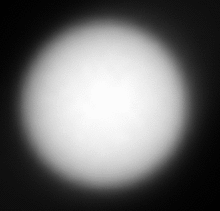Solar eclipses on Mars

The two moons of Mars—Phobos and Deimos—are much smaller than the Moon, greatly reducing solar eclipses on that planet.[1][2]
Eclipses caused by Phobos


Due to the small size of Phobos (about 20 by 25 km (12 by 16 mi)) and its rapid orbital motion, an observer on the surface of Mars would never experience a solar eclipse for longer than about thirty seconds. Phobos also takes only 7 hours 39 minutes to orbit Mars, while a Martian day is 24 hours 37 minutes long, meaning that Phobos can create two eclipses per Martian day. These are annular eclipses, because Phobos is not quite large enough or close enough to Mars to create a total solar eclipse.
Eclipses caused by Deimos
Deimos is too small (about 15 by 10 km (9.3 by 6.2 mi)) and too far from Mars to cause an eclipse. The best an observer on Mars would see would be a small object in transit across the Sun.
View from Earth
Both moons are too small to cast a shadow on Mars that can be seen from Earth. However, shortly after the first artificial satellites were placed in orbit around Mars, the shadow of Phobos was seen in pictures transmitted to Earth.
